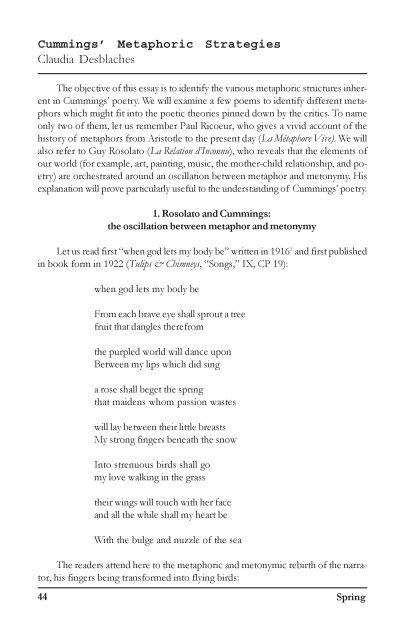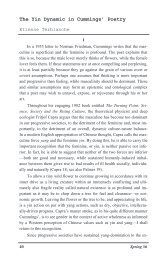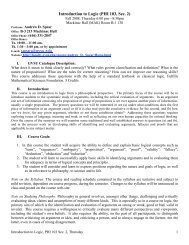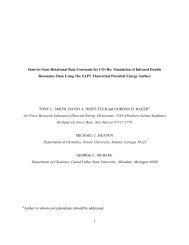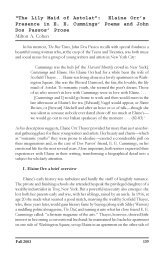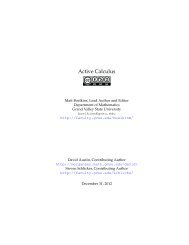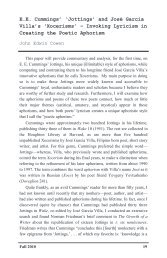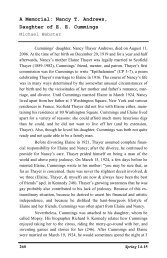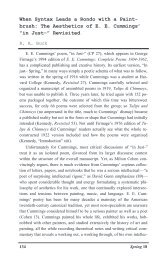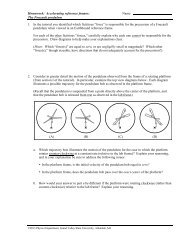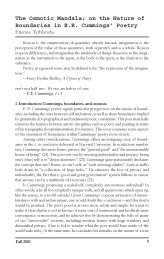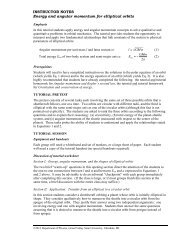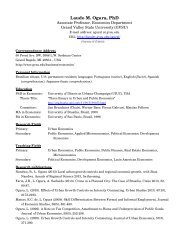Cummings' Metaphoric Strategies Claudia Desblaches - Gvsu
Cummings' Metaphoric Strategies Claudia Desblaches - Gvsu
Cummings' Metaphoric Strategies Claudia Desblaches - Gvsu
You also want an ePaper? Increase the reach of your titles
YUMPU automatically turns print PDFs into web optimized ePapers that Google loves.
Cummings’ <strong>Metaphoric</strong> <strong>Strategies</strong><br />
<strong>Claudia</strong> <strong>Desblaches</strong><br />
The objective of this essay is to identify the various metaphoric structures inherent<br />
in Cummings’ poetry. We will examine a few poems to identify different metaphors<br />
which might fit into the poetic theories pinned down by the critics. To name<br />
only two of them, let us remember Paul Ricoeur, who gives a vivid account of the<br />
history of metaphors from Aristotle to the present day (La Métaphore Vive). We will<br />
also refer to Guy Rosolato (La Relation d’Inconnu), who reveals that the elements of<br />
our world (for example, art, painting, music, the mother-child relationship, and poetry)<br />
are orchestrated around an oscillation between metaphor and metonymy. His<br />
explanation will prove particularly useful to the understanding of Cummings’ poetry.<br />
1. Rosolato and Cummings:<br />
the oscillation between metaphor and metonymy<br />
Let us read first “when god lets my body be” written in 1916 1 and first published<br />
in book form in 1922 (Tulips & Chimneys, “Songs,” IX, CP 19):<br />
when god lets my body be<br />
From each brave eye shall sprout a tree<br />
fruit that dangles therefrom<br />
the purpled world will dance upon<br />
Between my lips which did sing<br />
a rose shall beget the spring<br />
that maidens whom passion wastes<br />
will lay between their little breasts<br />
My strong fingers beneath the snow<br />
Into strenuous birds shall go<br />
my love walking in the grass<br />
their wings will touch with her face<br />
and all the while shall my heart be<br />
With the bulge and nuzzle of the sea<br />
The readers attend here to the metaphoric and metonymic rebirth of the narrator,<br />
his fingers being transformed into flying birds:<br />
44 Spring
My strong fingers beneath the snow<br />
Into strenuous birds shall go<br />
The narrator’s body parts (each brave eye, his lips, his heart), or further, his<br />
feelings (“my love walking in the grass”) spring up from the earth and transform into<br />
birds. Their flight recalls the conventional metaphor of sentimental exaltation and<br />
the liberation of the soul. It is as if Cummings gave movement to death in this<br />
oscillation between metaphor and metonymy. The initial metaphor (that of fingers<br />
being compared to birds) fits into a vital metonymy (“My strong fingers beneath the<br />
snow”) after the enjambment occurring when the inclusive preposition “into” comes<br />
into place.<br />
Like the new-born baby whose umbilical cord is suddenly severed from his<br />
mother to allow him to start in life, the metaphor takes its initial impulse on metonymic<br />
development. As Guy Rosolato acknowledges, it is precisely the close link to<br />
the real (“My strong fingers beneath the snow”) which gives birth to metaphor as a<br />
sudden change of meaning (“Into strenuous birds shall go”). If we look closely at<br />
Cummings’ poem, we will see that the first metonymic line, which reproduces what<br />
is familiar (the narrator describes his body parts and looks forward to his rebirth in the<br />
snow), gives the opportunity for a dauntless plunge into the unknown: the metamorphosis<br />
of the narrator’s fingers into vigorous birds. The tension towards the<br />
unknown is particularly at stake in this change from “strong” to “strenuous.” The<br />
adjective “strenuous” (which is of Latin origin and is more abstract than the adjective<br />
“strong”) reminds us of the fingers’ strength, thus ensuring a metaphoric impulse<br />
from a metonymic continuity.<br />
We could then conclude that Cummings’ poetry is partly based on this oscillation<br />
between metonymy (“From each brave eye shall sprout a tree”) and metaphor<br />
(“fruit that dangles therefrom // the purpled world will dance upon”), an oscillation<br />
recognized by Guy Rosolato as the ruling principle of literature, music, and the<br />
mother-child relationship. It is true that Cummings’ poems often start from the real<br />
before plunging into lyricism, or that lyrical outpourings are always related back to the<br />
real. To borrow a sentence from Cummings’ poetry, one could say that when “air is air<br />
and thing is thing:no bliss // of heavenly earth beguiles our spirits” (CP 675), but<br />
Cummings acknowledges also and demonstrates in his poetry that the literal power<br />
of words liberates “a deeper magic”:<br />
Mountains are mountains now;skies now are skies—<br />
and such a sharpening freedom lifts our blood<br />
as if whole supreme this complete doubtless<br />
universe we’d(and we alone had)made.<br />
Fall 2003<br />
45
The universe Cummings describes here is a subtle combination of metaphors<br />
and metonymies empowering each other. The poet has shown that happiness and<br />
plenitude are achieved via a metaphoric understanding of the world, a sort of metaphoric<br />
reading of the metonymic chain. Without this modification, things are things.<br />
The metaphoric-metonymic oscillation is a source of aesthetic pleasure, a necessary<br />
gap to favor psychological equilibrium, the definition of poetry, the reason for musical<br />
understanding. Like the new-born baby who understands the newness of other<br />
voices while listening to the reassuring voice of his mother, like the amateur who<br />
appreciates the spontaneity of musical variations grafted onto a pre-existing repetitive<br />
melody, the reader becomes receptive to the sudden leaps of meaning which disturb<br />
the initial metonymic order.<br />
Two readings can often coexist in Cummings’ poetry. For example in ‘I have seen<br />
her a stealthily frail’ (CP 147), in the lines “her body / will come toward me with its<br />
hurting sexual smell / of lilies,” two semantic nodes seem to revolve around the<br />
adjective “hurting”:<br />
Across the important gardens her body<br />
will come toward me with its hurting sexual smell<br />
of lilies….<br />
First, one could interpret the word in its inadequacy to qualify a smell and conclude<br />
that the metaphoric adjective qualifies the sentimental suffering of the subject<br />
“me” facing the object of his desires “her body.” The inappropriate adjective allows<br />
the subject to briefly express his feeling by a description of the object at the origin of<br />
his feelings. But why not propose a second reading and understand “hurting” as a<br />
metonymic adjective “Hurting” might refer to the penetrating smell of sex. Thus the<br />
word which appears as a metaphor can be revealed as a metonymy in favor of a<br />
controlled movement towards the real. Far from disclosing the irrelevance of some<br />
words, the adjective allows the description of the particular sexual odour.<br />
2. Substitution (Aristotle, Jean Cohen)<br />
Often the transition from the metaphoric order to the metonymic order can also<br />
be reversed. For example, in the expression “the velvet tiger of my soul” [“When<br />
parsing warmths of dusk construe” (CP 990)], the adjective ‘velvet’ creates the link<br />
between two nouns. The word qualifies the smoothness of the tiger’s fur (touch) and<br />
the toned down violence of the animal, a sort of oxymoron between velvety smoothness<br />
and cruel violence which designates the poet’s soul: “the velvet tiger of my soul<br />
. . . Leases sensation absolute”:<br />
46 Spring
The velvet tiger of my soul<br />
Washing in fundamental mind<br />
Elided chaos hating<br />
Leases sensation absolute<br />
The genitive metaphor indeed represents the fruitful union between two terms,<br />
“tiger” and “soul,” owing to the semantic intersection created by the adjective “velvet,”<br />
an intersection which is made concrete in the following predicate which defines<br />
sensation as “absolute.” The notion of the absolute arising from the compatibility<br />
between “velvet” and “tiger” allows the liberation from the usual limits of the denotative.<br />
The metonymic order of relativity seems to be invalidated by the metaphoric<br />
notion of the absolute. In this example, as in the line with the adjective “hurting,” it<br />
is less a matter of substitution (the usual theory of metaphor: the metaphoric word<br />
replaces the expected non-metaphoric word) than a close link or intersection between<br />
two terms.<br />
In this two-terms formula, “the velvet tiger of my soul,” the softness of velvet<br />
and the wildness of the tiger define the poet’s soul: lyrical outpourings generate<br />
unknown sensations. The logic revealed here gives the illusion of syntactic order: the<br />
lyricism and violence of the oxymoron spring syntactically as something relevant. If<br />
we consider this as a Cartesian metaphoric construction, is it still relevant to talk about<br />
the substitution theory or would it be more appropriate to think about another<br />
theory which relates two elements: a supposed “tenor” (“soul”) and a “vehicle”<br />
(“tiger”) which interact and fuse into the predicate (“Leases sensation absolute”)<br />
3. Interaction (I. A. Richards, Max Black, Beardsley)<br />
The genitive metaphor, which is thus no longer apprehended solely on the lexical<br />
level, has to be replaced within the whole sentence or within a larger poetic context.<br />
The poet as a liberating Emersonian god (“the poet . . . speaks somewhat wildly . . .<br />
‘with the flower of the mind’” [319]) generates mature liberating thoughts ready to<br />
flood men’s hearts. The velvet ferocity of the tiger could be read as the vehicle for<br />
aspiration or “the melodious ascension of the poet,” as Emerson puts it in his essay<br />
“The Poet”:<br />
[W]hen the soul of the poet has come to ripeness of thought, she detaches<br />
and sends away from its poems and songs, . . . a fearless, vivacious offspring<br />
clad with wings . . . which carry them fast and far and infix them irrevocably<br />
into the hearts of men. These wings are the beauty of the poet’s soul. . . .<br />
[T]he melodies of the poet ascend, and leap and pierce into the deeps of<br />
infinite time. (Emerson 317)<br />
Fall 2003<br />
47
If I have taken some time to show that metaphors should be understood not<br />
only on the simple level of words but also on the syntactic level or within a larger<br />
intertext, it is because this gap from the metaphoric word and a larger metaphoric<br />
context will favour the emergence of the interaction theory and discard that of substitution.<br />
It is I. A. Richards who invents the notions of tenor and vehicle which allow<br />
a redefinition of metaphor as any expression linking two active ideas together.<br />
The idea of interaction between two words could be identified in a haiku particularly<br />
cherished by Cummings. The haiku’s interpenetration of things might be understood<br />
as an echo of I.A. Richards’ interpenetration of the parts of discourse. In the<br />
notes at the Houghton Library at Harvard University, Cummings copied out a similar<br />
idea from R. H Blyth’s book on Haiku: “The more the mind endeavours to distinguish<br />
two things, the closer they insensibly become; the more they assert their unity,<br />
the more they separate” 2 These two things which interpenetrate correspond to what<br />
Beardsley, I. A. Richards and Max Black identify as tenor and vehicle or frame and<br />
focus. Let us first remember how one line in “Do you remember when the fluttering<br />
dusk” (CP 863) functions:<br />
Then from the world’s harsh voice and glittering eyes,<br />
The awful rant and roar of men and things,<br />
Forth fared we into Silence. The strong wings<br />
Of Nature shut us from the common crowd;<br />
On high, the stars like sleeping butterflies<br />
Hung from the great grey drowsy flowers of cloud.<br />
The comparison between the stars and the sleeping butterflies allows us to<br />
identify a tenor and a vehicle which are later reactivated to create a genitive metaphor:<br />
“the great grey drowsy flowers of cloud.” The comparison has paved the way for the<br />
emergence of a metaphor deeply anchored in the real: the sleeping butterflies belong<br />
to the same isotopy as the drowsy flowers ready to be gathered. The vegetal attributes<br />
are thus projected into the sky without undermining the credibility of the description<br />
.<br />
The genitive metaphor “flowers of cloud” represents at the same time a fusion<br />
and a separation between the tenor “stars” and the vehicle “butterflies.” It is owing to<br />
the initial comparison (the stars are compared to sleeping butterflies) that the metaphor<br />
can be understood: the drowsy flowers of cloud represent the stars. In other<br />
words, the comparison A1 is like B1 (the stars like sleeping butterflies) generates the<br />
metaphor B2 of A2 (the great grey drowsy flowers of cloud). There has thus been a<br />
transition from comparison to metaphor owing to the interactive qualities of the<br />
words “stars,” “cloud,” “butterflies,” and “flowers.”<br />
By briefly studying another poem entitled “she being Brand” (CP 246), I would<br />
like to show how Cummings in a way applies this interaction theory I have just<br />
48 Spring
explained, combining it with another theory—that of iconicity. Cummings comically<br />
creates confusion between the interchangeable vehicle and tenor: the woman and the<br />
car. The metaphoric interaction between the two, as well as the more tangible interaction<br />
between the narrator and the woman, is exhibited in the extravagance of typography.<br />
In other words, interaction is iconic here.<br />
4. The iconic moment of metaphor (Paul Henle, Marcus B. Hester)<br />
Owing to this successful mixing of interactive metaphors and icons, Cummings<br />
seems to reinvent what has been pinned down by Paul Henle and Marcus B. Hester as<br />
the iconic metaphor: the metaphoric word is understood as it interacts with other<br />
radioactive words. According to Henle, metaphors are the subtle transformation of<br />
literal meaning into a figurative meaning. It is as if a figural interpretation preserved<br />
within itself the original literal meaning. According to Hester, poetic language presents<br />
a certain fusion between sensations and meanings, what is verbal and nonverbal,<br />
sensation and logic fuse into the power of language to create images.<br />
One could take several examples from Cummings’ poetry, the most famous one<br />
probably being “(im)c-a-t(mo)” (CP 655), in which the poet skillfully creates a morphological<br />
instability which represents the potential leaps of the cat. The severed<br />
letters (e.g., “b,i;l:e” or “leA / ps!”) show the surprising rebounds of the cat:<br />
(im)c-a-t(mo)<br />
b,i;l:e<br />
FallleA<br />
ps!fl<br />
OattumblI<br />
The poem’s charm lies in the confusion between the mobility and immobility<br />
characteristic of the abrupt suppleness of the cat. In Cummings’ poem “she being<br />
Brand,” the woman is given the usual attributes of the car by a chauvinistic, saucy, and<br />
conniving narrator (“you know”). This poem takes the notion of vehicle literally. A<br />
vehicle is indeed started by a competent driver-lover:<br />
she being Brand<br />
-new;and you<br />
know consequently a<br />
little stiff i was<br />
careful of her and(having<br />
thoroughly oiled the universal<br />
joint tested my gas felt of<br />
Fall 2003<br />
49
her radiator made sure her springs were O.<br />
K.) (CP 246)<br />
Two readings coexist here, a literal one (that of a car being started) and a figurative<br />
one (that of the virginity of a woman being taken). The interaction between two<br />
interpretations echoes the interaction between tenor and vehicle, woman and car.<br />
Another well-known poem by Cummings fuses the figurative and literal interpretations.<br />
In “weazened Irrefutable unastonished” (CP 253), the large twenty moving<br />
fingers are mentioned as such and seem to be moving as our reading eye encounters<br />
the alternation between lower case and upper case letters:<br />
weazened Irrefutable unastonished<br />
two,countenances seated in arranging;sunlight<br />
with-ered unspea-king:tWeNtY,f i n g e r s,large<br />
four gnarled lips totter<br />
The alternation between letters represents sign language, the way deaf persons<br />
communicate, replacing their lack of speech by means of their “four gnarled lips<br />
tottering.” Shall we say that the words “:tWeNtY,f i n g e r s,large” represent the<br />
fusion between the tenor (sign language) and the vehicle (the typographic form of the<br />
letters or moving fingers) In this case, the icon is represented, empirical reality appears<br />
textually in linguistic and typographic manipulations: the segment “:tWeNtY,f<br />
i n g e r s,large” mimes the movements of both hands as if the author wanted to<br />
focus directly on his mimetic intention. 3<br />
And we reach here the central point in Cummings’ metaphors, which are always<br />
closely attached to the real. In his original definition of metaphors from the Houghton<br />
notes, Cummings assimilates metaphors to various material elements taken from the<br />
real: microbes, sounds, flavours, and silences. Cummings’ definition of metaphor<br />
seems to be quite close to that of metonymy since metaphor is a vivid and real entity.<br />
Metaphors are systematically projected onto the world:<br />
I have just realized something, the silences and the solidities which we call<br />
things are not things but metaphors. Metaphors are the hoppings of one<br />
thing to another which we mistakenly call ideas: they copulate in laughter, in<br />
your smallest gesture are born myriads which die in the next and incredibly<br />
are reborn; they are eaten and drunken, we swallow them and we breathe<br />
them, under different names: we do not stroke edges and feel music, but<br />
only metaphors. They are the brightness. There are a billion on an instant,<br />
on a coatsleeve. They are what we call sounds and flavours, the difference<br />
between this face and another 4 .<br />
50 Spring
Although Cummings’ definition makes a scandalous juxtaposition of different<br />
elements, his definition seems to condense the different theories we have tried to<br />
explore above.<br />
The real being the starting point of the poetic revelation, one quickly understands<br />
that metaphors also imply an adequate metonymic reading of the world. The<br />
disappearance and immediate rebirth of metaphors (“in your smallest gesture are<br />
born myriads which die in the next and are incredibly reborn”) recalls Rosolato’s<br />
metaphoro-metonymic oscillation. Further on, metaphors are considered as constellations<br />
(“myriads,” “they are the brightness,” “There are a billion on an instant”), and<br />
one remembers the radioactivity of words and the interaction theory as well as the<br />
interpenetration of things.<br />
All these references which generate an enigmatic and polymorphous definition<br />
of metaphor demonstrate that the debate is open, that many theories seem to be<br />
valid according to this amazing definition. We have seen that in ‘when god lets my<br />
body be,’ metaphors take their impulse from the poetic reading of the metonymic<br />
axis. In “I have seen her a stealthily frail,” metaphors hesitate between substitution<br />
(“Metaphors are the hoppings of one thing to another”—they are “the difference<br />
between this face and another”) and interaction (“There are a billion on an instant”).<br />
This tension seems to favor a controlled back movement towards the real (we “mistakenly”<br />
call metaphors “ideas”; “they are eaten and drunken”). The metaphoric word<br />
cannot be understood in relation to the replaced entity but to other “radioactive”<br />
surrounding words.<br />
Since “things are not things but metaphors,” it seems impossible to read the<br />
world through analogical lenses; on the contrary, Cummings invites readers to read<br />
anomalies hidden under analogies and metaphors in the real world. Owing to poetry,<br />
readers can apprehend the real differently, the implicit equivalence between words and<br />
things being questioned here. Cummings reminds readers that the objects of the<br />
world were named according to an inspired apprehension of the real world. Each<br />
named object originally comes from a metaphoric reading of the world which has<br />
been lost and which Cummings tries to reactivate. Each named thing is a former vivid<br />
metaphor that readers should bring back to life. Cummings refutes a literal reading of<br />
the world; we can be attentive to the poetic ecstasy the world offers.<br />
—Université de Cergy-Pontoise, France<br />
Fall 2003<br />
51
Notes<br />
1 According to Kennedy, Cummings wrote this poem as a part of Dean Briggs’<br />
versification class at Harvard (92).<br />
2 Notes at the Houghton Library, Harvard University, bMS, Am 1823.7 (23) Notes to<br />
this book may also be found at bMS Am 1823.7 (64), folder 4 and bMS Am<br />
1823.7 (64), folder 5.<br />
3 [Editor’s note] The reader might notice that there are twenty typed characters before<br />
and after the colon.<br />
4 Notes at the Houghton Library, Harvard University bMS Am 1823.7 (25) folder 8,<br />
sheets 162 and 223. Cohen notes that this passage is quoted almost verbatim in<br />
a scene in Him, pp. 28-29 (Cohen 153).<br />
Works Cited<br />
Cummings, E. E., Complete Poems, 1904-1962. Ed George J. Firmage. NewYork:<br />
Liveright, 1991.<br />
—. Him. New York: Boni and Liveright, 1927. Reprinted. New York: Liveright, 1955,<br />
1970.<br />
—. Miscellaneous Notes at the Houghton Library, Harvard University.<br />
Cohen, Milton A. PoetandPainter: The Aesthetics of E. E. Cummings’s Early Work.<br />
Detroit: Wayne State UP, 1987.<br />
Emerson, Ralph Waldo. Selected Writings of Ralph Waldo Emerson. Ed. William H.<br />
Gilman. New York: NAL, 1983.<br />
Kennedy, Richard S. Dreams in the Mirror: A Biography of E. E. Cummings. New York:<br />
Liveright, 1980.<br />
Ricoeur, Paul. La Métaphore Vive, Editions du Seuil, 1975.<br />
Rosolato, Guy. La Relation d’Inconnu, NRF, 1978.<br />
52 Spring


